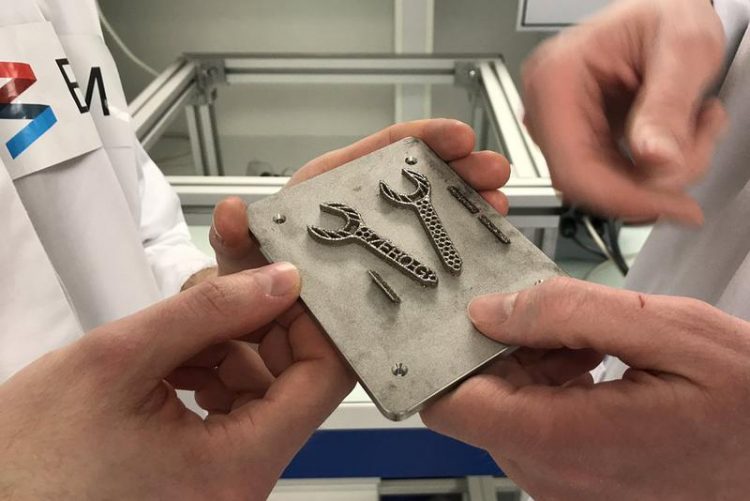BAM@Hannover Messe: innovative 3D printing method for space flight

That's how it looks like: The first ever in zeroG printed spanner made of metallic powder Source: BAM, Section Corporate Communications
Powder-based additive manufacturing in zero gravity is the name of the project in which a component is produced by applying metallic powder layers and then fusing it using selective laser sintering. Production is controlled by data models.
Metallic powder is locally melted by intensive laser radiation in each layer. What makes this method special is that the application of the powder layers takes place under zero gravity conditions. For this purpose, a process gas – in this case nitrogen – is drawn through the powder layers in order to stabilise the powder bed without gravity.
The procedure has already been successfully tested in two parabolic flight campaigns in cooperation with the Clausthal University of Technology, and the Institute for Composite Structures and Adaptive Systems of the German Aerospace Center (DLR) in Braunschweig.
Metallic powders pose a challenge because they are potentially flammable and explosive. But the research group has developed a method that enables processing of metallic powders in space under a protective gas atmosphere.
“We used a completely new technology to print a wrench for the first time under zero gravity in our latest parabolic flight campaign in March,” explains Prof. Jens Günster, project manager and head of BAM’s Ceramic Processing and Biomaterials division. “We are pleased to be able to present our research results at the Hannover Messe and show our method’s potential to the space industry.”
Some of the processes used have already been internationally patented. They are based on two patent families that were jointly registered by BAM and Clausthal University of Technology within Germany and by BAM alone outside Germany.
BAM at the Hannover Messe 2018
At the BAM stand C 51 in Hall 2 Research & Technology visitors can receive additional information about this topic.
For more information about what BAM is presenting at the Hannover Messe, please visit www.bam.de/hannovermesse_en
Contact:
Venio Quinque, M.A., LL.M./LL.B.
Head of Section Corporate Communications
Bundesanstalt für Materialforschung und –prüfung (BAM)
Unter den Eichen 87
12205 Berlin
GERMANY
T: + 49 30 8104-1002
F: + 49 30 8104-71002
venio.quinque@bam.de
About BAM
BAM promotes safety in technology and chemistry.
As a departmental research institute of the German Federal Ministry for Economic Affairs and Energy, BAM performs research, testing and offers advisory support to protect people, the environment and material goods. Its activity in the fields of materials science, materials engineering and chemistry is focussed on the technical safety of products and processes.
BAM’s research is directed towards substances, materials, building elements, components and facilities as well as natural and technical systems important for the national economy and relevant to society. It also tests and assesses their safe handling and operation. BAM develops and validates analysis procedures and assessment methods, models and necessary standards and provides science-based services for the German industry in a European and international framework.
Safety creates markets.
BAM sets and represents high standards for safety in technology and chemistry for Germany and its global markets to further develop the successful German quality culture “Made in Germany“.
Media Contact
All latest news from the category: Trade Fair News
Newest articles

A universal framework for spatial biology
SpatialData is a freely accessible tool to unify and integrate data from different omics technologies accounting for spatial information, which can provide holistic insights into health and disease. Biological processes…

How complex biological processes arise
A $20 million grant from the U.S. National Science Foundation (NSF) will support the establishment and operation of the National Synthesis Center for Emergence in the Molecular and Cellular Sciences (NCEMS) at…

Airborne single-photon lidar system achieves high-resolution 3D imaging
Compact, low-power system opens doors for photon-efficient drone and satellite-based environmental monitoring and mapping. Researchers have developed a compact and lightweight single-photon airborne lidar system that can acquire high-resolution 3D…





















